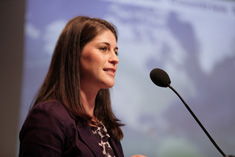-
“See What Story the Data Tells”: PAI’s Gina Sarfaty on Mapmaking With a Purpose
October 25, 2013 By Laura Henson
“Maps are inherently compelling because they contain a high resolution of information and most people have really been trained since grade school on how to read a map,” says Population Action International mapping specialist Gina Sarfaty in this week’s podcast.
“Maps are inherently compelling because they contain a high resolution of information and most people have really been trained since grade school on how to read a map,” says Population Action International mapping specialist Gina Sarfaty in this week’s podcast.
“At PAI we were creating traditional publications and realized that climate change findings scattered across different publications would be useful and compelling to show in one place.” Sarfaty has helped PAI, a reproductive health advocacy NGO, build an interactive website illustrating overlapping data sets on climate change vulnerability, projected declines in agricultural production, and rapid population growth to show “hotspots” where improved access to family planning could help alleviate a number of pressures.
“The effects of rapid population growth, high agricultural decline, and low resilience to climate change will pose challenges in many parts of the world,” she says. “We actually identify 30 population and climate change hotspots…where greater attention needs to be paid to the relationship between population and climate change.”
The intention of the website, Sarfaty explains, is to bridge PAI’s advocacy campaigns with its research. A guided tour section of the site has a set of pre-made maps accompanying a specific narrative. The linear format keeps “the messages clear and accessible to users, so that they aren’t left trying to put the pieces of the puzzle together to really figure out what the key takeaways are,” she says. But there is also a do-it-yourself, “explore” section where users have access to additional data and can draw their own maps and conclusions.
The site also serves as a dissemination tool for PAI’s partners in developing countries, says Sarfaty. “Often there was a challenge of a mutual understanding of terms, but it was great to be able to customize maps and send them over to our partners to make sure that they were getting things that were effective.” Because many of their partners work in places with poor or unreliable internet access, Sarfaty says they made sure the maps can be distributed via hardcopy, USB drives, or email.
The site has a clear goal – to make the connection between access to family planning and adaptation to climate change – but Sarfaty cautions against deciding on a narrative and then cherry-picking data to fit it. “I would really recommend starting with the data and seeing what story it tells…Often times if you look at the data first, you may find that it tells a completely different, but also compelling, story that you may not have thought about before.”
Sarfaty spoke at the Wilson Center on September 30. Download her slides here.
Friday podcasts are also available for download on iTunes.
Sources: Population Action International.
 A Publication of the Stimson Center.
A Publication of the Stimson Center.




